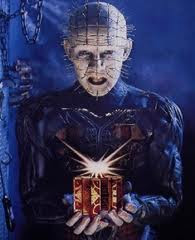 |
| Merkin Vineyards, Arizona. Makers of Caduceus wine |
"No other god, let alone Athena with her sober olive oil, or Demeter with her nourishing bread, had ever had anything that could vie with that liquor. It was exactly what had been missing from life, what life had been waiting for: intoxication (36)."
Dionysus the god of wine, vegetation, pleasure, and festivity; "revealed the secret of wine to man (37)." Dionysus like most of the gods exhibits a duality that is ever present in humans and in life. Although he gives humans the secrets of wine and pleasure, as well as the uniting practice of festivity, he was also murderous and a rapist. Dionysus longs to posses the unattainable, but once he has it he becomes easily bored and often casts women aside like a spoiled child that has tired of his toy. Grapes and the wine that is produced from them are an important part of our origins. Wheat and grapes are central to origins of agriculture and civilized life. Wine is familiar to most of us for its role in celebration and ritual. Wine is recurrent theme throughout several cultural mythologies including Christian mythology. The documentary "Blood Into Wine" explores the origins of Merkin Vineyards in Arizona. Winemaker Eric Glomski describes the wine making process as one that is complex and brings humans back to nature. His passion for wine has led him to develop his sense of smell as ninety percent of tasting wine is smelling wine. For Eric and his partner Maynard Keenan wine is a connection to the Earth and to our collective origins. Wine making is a hugely complex process where everything is a factor the soil, the slopes, the rain fall; all of these wonderful elements come together to create a divine beverage that is used in celebration and deception. Wine both enhances and dulls the senses. A dualistic drink, from a dualistic god, for dualistic beings.
"Dionysus decided that only one of his weapons could work: wine (31)." Wine produces great merriment, occasional sorrow, or can be used as a weapon of revenge. Dionysus rapes Aura by drugging her with wine so that Artemis can have her revenge. Why would such a good time party guy do such a thing? Because Artemis had delivered death to many of Dionysus' women at his request. Dionysus has a dark side and by revealing wine to mortals he revealed pleasure and pain, by combining the two into an intoxicating drink that is capable of producing both of these primal sensations.
The origins of a vineyard, the origins of wine, the origins of pleasure, of pain, of the gods themselves; all this talk of origins has me thinking of my own origins. My mother has always insisted that i was found under a rock. All my father has ever said was that the night I was born the radio played nothing but great songs. Zeppelin, Skynard, Sabbath, and Cream poured out of his speakers as if Orpheus himself had seized the airwaves to announce my birth. The wine flowed freely and Dionysus nodded his approval. For it was he, with his wine and festivity, that led my parents to each other in the first place. My youth was filled with barbecues, holiday feasts, and always always music. I don't remember when I stopped believing in Santa Claus, but i do remember that at 8 years old I was given to Orpheus body and soul through a ritual know as ones first concert.
I know I believed in Santa Claus, but I honestly don't remember when or why i stopped. My grandfather had a beard of ZZ Top proportions and when i was little the other little kids would walk up to my grandfather and accuse him of being Santa Claus. I always thought this was silly surely my grandfather couldn't be THE Santa Claus. The REAL Santa Claus lived in the North Pole not in Wyoming.
-------------------------------------------------------------------------------------------------------------
I'm a little over half done with "Cadmus and Harmony". Calasso is intoxicating, this book is amazing, a real page turner. It's poetic, beautiful; full of life, death, perversion, and revenge. It truly does explain why we are the way we are and answers questions we dare not ask.
-------------------------------------------------------------------------------------------------------------
Class Notes 9/6:
Origins of music start when Hermes gives the lyre to Apollo
Homeric Greeks- believed that 'only the gods can be the causes' of desire, suffering, & reflection
Diamon = Demon
Ate = infatuation, you are no longer in control of the situation
Enthusiasm- comes from Theos, means possessed by the gods
Alchemy- perfection of the human spirit
9/8:
Etiology- explanation of how something came to be- 2 levels simple and complex- etiological myth explains origins of practice, natural phenomena, and proper names
Mythology is a system of total explanation that answers all questions
Myth- is the model for imitation
Anamnesis- innate knowledge, you already know everything you need to know you just forgot the role of the teacher is to awaken our recollection and help us remember
Test: Homeric hymns, Classic dramas, Hesiod, Trojan War, Exodus










